SPAWING: CLARIAS GARIEPINUS (AFRICAN MOULD FISH, AFRICAN SHARP TOOTH)
INTRODUCTION
In aquatic animals, reproduction is carried out through the release of eggs and sperm from both sexes respectively into their habitat (water). The act exhibited by both sexes is referred to as spawning.
Most aquatic animals with an exception to the class Mammalian and Reptilia exhibit spawning characteristics as a means of reproduction. Spawns, are made up of active cells (reproductive) called gametes, in many aquatic animals, some of which becomes fertilized thereby producing offspring.
Spawning typically entails the release of unfertilized eggs (ova or ovum) into water, most times in numerous quantities, while the sexually active males sequentially (simultaneously) release “Milt” (spermatozoa) to fertilize the eggs.
Examples of some aquatic animals that reproduce through the process of spawning includes: most fishes (Carp and Clarias gariepinus), Crustaceans (Crabs and Shrimps), Echinoderms (Sea Urchins and Sea Cucumber), Molluscs (Oysters and Squid), Amphibians (Frogs and Newts), aquatic Insects (May flies and Mosquitoes and Corals).
The African catfish breeding season in the wild usually commences with the advent of the rains. The coming of the rains in tropical Africa is mainly characterized with extreme temperature fluctuations. These fluctuations could prevent high survival of the African catfish fry. In addition to these limiting factors for securing viable and good catfish seeds, African catfish fingerlings caught from the wild could have in one way or the other experienced stunted growth due to lack of readily available good food.
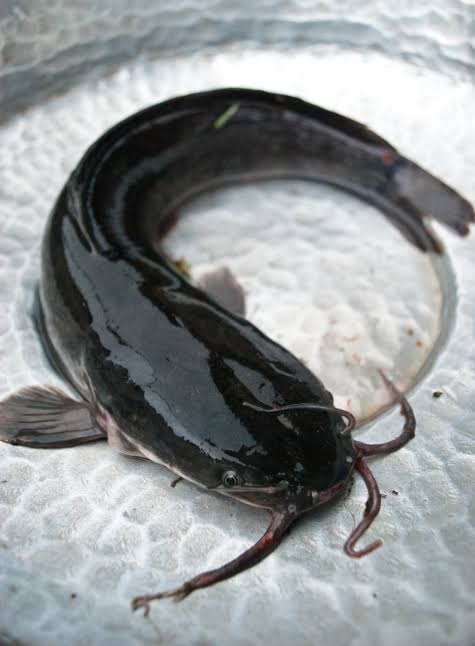.jpg)
image source
Steps of propagation
These steps are prone to changes as these methods are not fixed because anyone can decide to upgrade their methods of spawning catfishes.
The African catfish could be propagated in several ways. These ways are basic, though dynamic. The following steps are from Greenland Farm's own experience in propagating the fish.
Step 1:Identify and separate the sexes.
.jpg)
image source
The male and female of the African catfish can be easily recognized. The male has a distinct sexual papilla, elongated and located just behind the anus. This sexual papilla is usually red at the tip for sexually ready males. It is absent in females.
.jpg)
image source
A gentle press on the belly of the female fish towards the genital opening releases the ripe eggs indicating the readiness and viability of the female.
A sexually ready female has a swollen, usually reddish genital opening. A view from the top also gives a female African catfish away since either side of the belly appears swollen.

image sourceStep 2: Select and check for a gravid male and female (i.e. female with ripe eggs). The process of selection for gravid sexually active male and female African catfish includes :
FEMALE
- Choose only female fishes that weigh above 1kg.
- Female fish should have a Well-rounded and soft abdomen.
- Eggs, showing clearly the nucleus in the centre.
- Genital opening is swollen and sometimes reddish or rose in colour.
- When pressing out the female eggs for “inspecting” choose only the female fish that have eggs that separate from each other and are golden in colour
- Make sure that the outlet where the egg of the female fish will come out is slightly dark in colour.
- Make sure that the tummy of the female fish slightly protrudes out, when placed flat-faced down.
MALE
- Choose only male fishes that weigh above 1kg.
- No clear external symptoms to indicate the maturity.
- Elongated and slender in body shape
- Swollen urogenital papilla
- Make sure the male organ “crosses” and its pink at the dot end.
These are the basic features to distinguish between a male catfish and a female catfish.
NB:
It is not every female fish with bulging stomach that has ripe egg for hatchery. The best way to know is through the genital papilla. The genital papilla will be swollen, pinkish or brown in colour. With this, you will know it has mature eggs. Female catfish genital papilla is shorter than that of the male.
Choose only male and female fishes that weigh above 1kg so that the fries will also grow very fast. Some fish hatchers use broodstock of less than 1kg which is not good because the fries may not to grow well.
You may come across green eggs during stripping. They are also good but the golden/light brown eggs are better. Even better than the pure black ones. Milt size is not weight-dependent in males. Tiny milt has been seen in males above 4kg, so you should understand that it’s not by size.
- Step 3: Weigh the Female Fish
The male and female African catfish selected for spawning purposes, should weigh above 1kg.
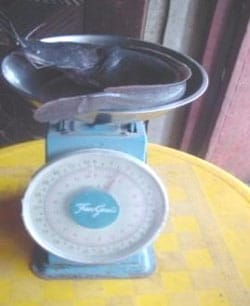.jpg)
image source
.jpg)
image source
Dried African Catfish Pituitary Gland
Put the pituitary inside a laboratory mortar.
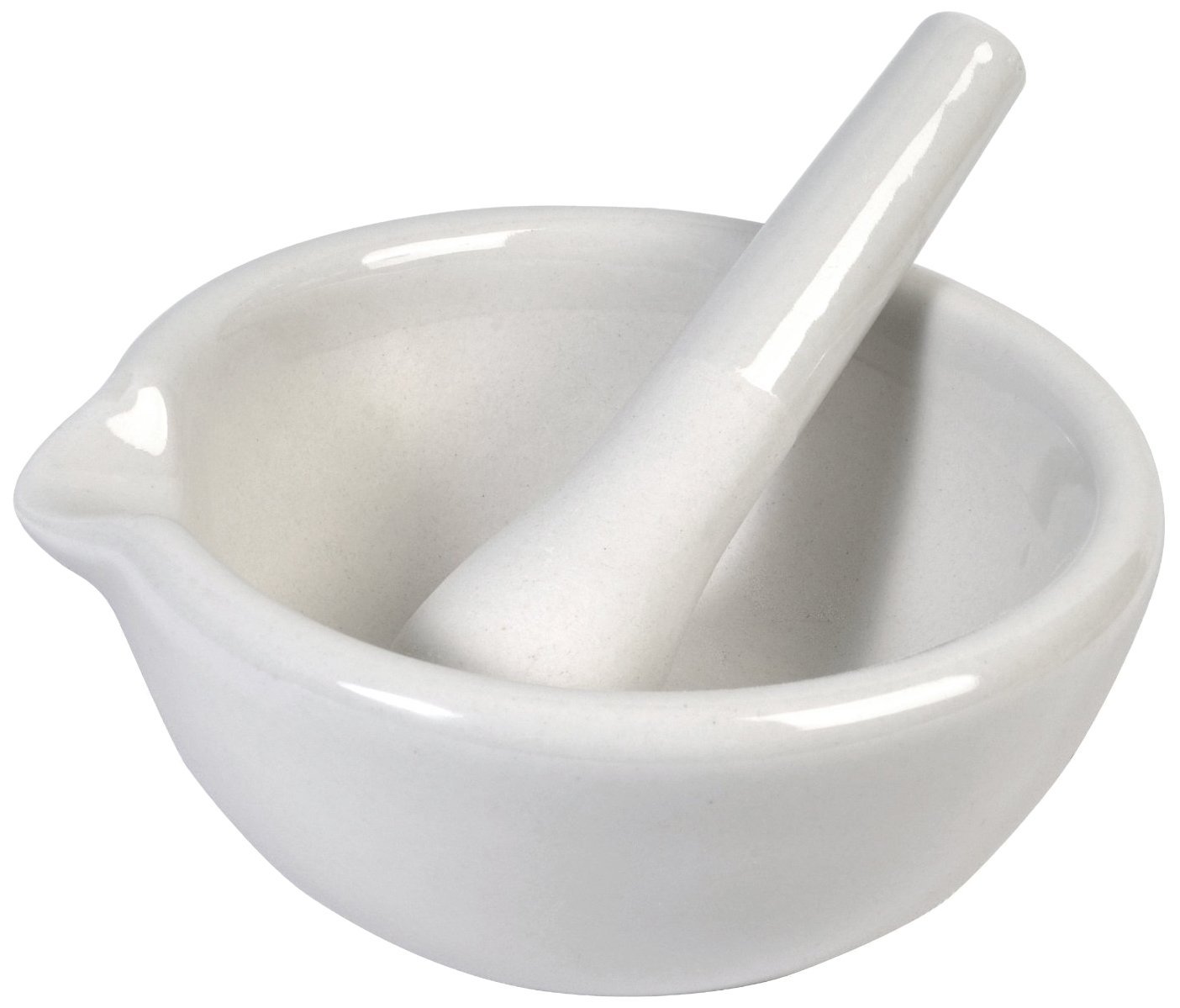
image soirce
Grind the pituitary using a pestle until it becomes powder.
Add 1ml saline solution.
.jpg)
image source
Collect the solution and Inject the female fish using an hypodermic Syringe.
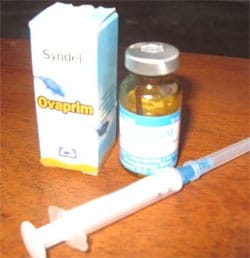
image source
Ovaprim, an example of a synthetic hormone.
This is done to have an idea of the weight of the egg inside the fish. From my own experience, I can guess that 8 -15% of the weight of a gravid female fish is the weight of the eggs.
A female catfish that therefore weighs 500grams has the weight of the egg to be 50 grams. A gram of egg contains approximately 700 eggs.
Thus a gravid female African catfish with a weight of 500grams could boast of 35,000 eggs. The viability of the eggs depends on brood stock care and management.
- Step 4: Prepare the female Catfish for injection
African catfish pituitary is commonly used for induced catfish breeding. Methods of removal and preservation of the pituitary are not contained in this book.
For induced breeding of the African catfish, I like to the use the pituitary gland, either freshly removed or ethanol preserved. I recommend a ratio of 1:1, recipient: donor i.e. if the weight of the female fish to be induced is 1kg, the weight of the donor fish, male or female should also be 1kg for freshly removed pituitary.
However, for dried, preserved pituitary, I recommend a ratio of 1:1.5 i.e. recipient fish should be 1kg and the donor fish should weigh 1.5kg. I will like to state here that it is not compulsory that the donor fish should be one fish; it could be 2 or 3 fishes with a combined weight of 1.5kg or as the case may be in weight.
A synthetic hormone can also be used. Usually, the manufacturer will include the prescribed dosage suitable for The African Catfish breeding.
When you want to inject the fish, please don’t inject the fish on the lateral line. I personally prefer the syringe pointing towards the tail of the fish. The fish should also be injected above the lateral line with the needle at 45 degrees to body of the fish.

image source
When you want to inject the fish, please don’t inject the fish on the lateral line.
I personally prefer the syringe pointing towards the head of the fish. The fish should also be injected above the lateral line with the needle at 45 degrees to body of the fish.
Note that this process should be done while the fish’s head is covered with a moist towel. This allows the fish to remain calm throughout the 18 entire process.
Step 5: Isolate the Injected fish in a Comfortable, big bowl and wait for 10 to 12 hours.
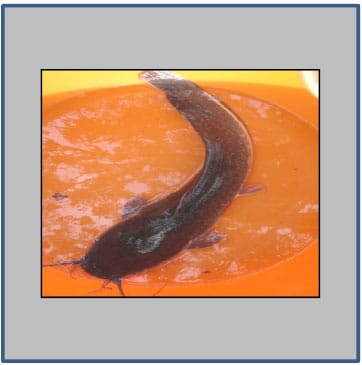
image sourceStep 6: Prepare to strip the fish, Set up your incubator.
Step 7 and 8: Bring the Fish out after 10 to 12 hours gently and cover the head with a clean, moist towel, wipe the body of the fish dry using a dry, soft towel.
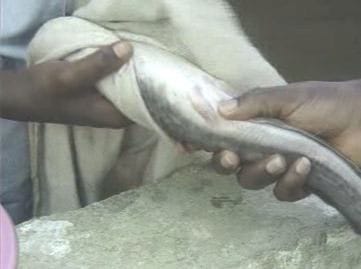
image sourceStep 9: Strip the fish (i.e. press the eggs out of the fish).
.jpg)
image source
Photograph showing how to gently press the Female African Catfish abdomen to collect the eggs
The pituitary injection makes the fish ready to release the eggs. In fact after the injection has been administered to the fish, following the right dosage, the process of getting the eggs out of the fish is irreversible.
At the onset of blood coming out with the eggs, the exercise should be stopped at once.
Step 10: Weigh the stripped eggs
This helps to have an idea of the expected fry.
.jpg)
image sourceStep 11 and 12: Bring the Male out, kill it, turn the belly up and cut it open and Remove the milt sac

image sourceStep 13-16: Cut the testicles into bits to release the sperm, Add saline solution to the milt, Pour the mixture of saline solution and milt to the stripped eggs in the bowl and Mix thoroughly and add fresh, clean, water.
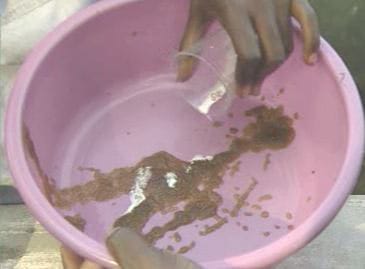
image source
The Saline solution added to the milt (sperm) keeps the sperm alive but not active. The saline solution makes it easy for the entire stripped eggs to be saturated with the milt. The subsequent addition of fresh, clean water now makes the sperm active and motile.
It is the addition of clean water that initiates the external fertilization process. This whole process of fertilization lasts for only about 60 seconds. That is why I strongly advice that you increase percentage fertilization by stirring the mixture during this 60 seconds. Continue mixing to prevent eggs from sticking together.
- Step 17: Spread the eggs inside the incubator on the Spawning sponge.
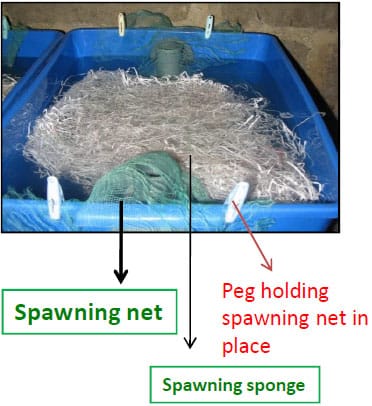
image source
The spawning sponge is completely immersed in water. It however sits on the spawning net which keeps it suspended in the water. The net is held in place by pegs.
- Step 18: Wait 20 to 36 hours: After 20 to 36 hours, remove the sponge and spawning net. By now the fry would have emerged from the hatched eggs and would have gone to the bottom of the net.
The un-hatched ones, now attached to the spawning sponge and spawning net are removed from the water since they would be attacked by fungi if left for too long. This fungi would inevitably attack the hatched eggs at the bottom of the net.
- Step 19: Observe the newly hatched eggs, with yolk still visible and attached to the fry.
For further illustration please watch the video below.





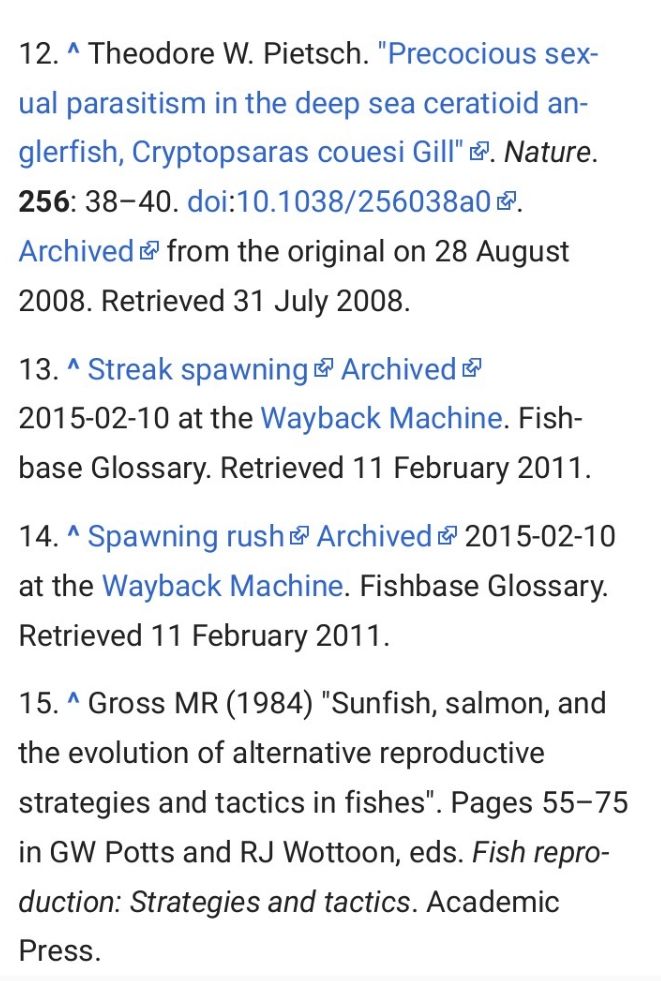


Hi! I am a robot. I just upvoted you! I found similar content that readers might be interested in:
https://thefishsite.com/articles/19-steps-to-efficient-african-catfish-breeding
Nice read. I leave an upvote for this article thumbsup